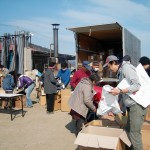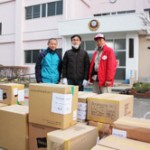On the 29th, JEN distributed fleece clothing and underwear that was donated by UNIQLO to evacuees in Ishinomaki (Miyagi Prefecture). The UNIQLO employees assisted in delivering these goods to more than 750 residents at three sites that had been announced on the radio. JEN is also distributing other items donated by its supporters, such as precooked and sealed food, canned food, powdered milk, etc.
Another JEN team has arrived in Ishinomaki to help in the distribution of hot meals at evacuation centers and in removing mud from the centers and local homes. It is also continuing to identify unreached or underserved communities and to assess needs.
The AAR Japan is working to respond quickly to calls for assistance. On the 30th, it reached more than 400 people at various evacuation centers and nursing homes in Miyagi Prefecture. They received a call from an evacuation center at the Saiwaicho Elementary School in Sendai that had been receiving support from the government and neighbors, but they were badly in need of clothing—especially socks and underwear. AAR was able to respond quickly and provided 14 boxes of underwear and other clothing as well as towelettes, sweets, and other items. AAR delivering supplies to evacuees housed at the Saiwaicho Elementary School.
A team from AMDA has been working at an evacuation center in Kamaishi (Iwate Prefecture) housed at an elementary school. The team was invited to attend a graduation ceremony held there on the 29th. In Japan, the school year ends in mid-March, so the earthquake struck at a time when many Japanese school children were about to graduate, causing those ceremonies as well as the start of the new school year to be postponed.
In Otsuchi (Iwate Prefecture) and Minamisanriku (MiyagiPrefecture), AMDA teams continue to provide care at evacuation centers and through mobile clinics, trying to reach those who are unable to get to the centers. Because they are seeing increasing signs of stress and mental illness, teams of psychiatrists and mental health counsellors are being formed to assist the evacuees. On the 31st, a team of medical personnel from Thailand arrived in Japan and will join the AMDA team in Otsuchi.
NICCO staff similarly reported on the need for mental health care for the survivors. As the NICCO staff spoke to evacuees in Rikuzentakata, they heard stories of how quickly the tsunami came upon the town, bringing with it waves that by some reports reached a height of 50 m (164 ft.). Those who took the time to try to reach loved ones or to get important documents from home or work simply did not survive. Two weeks later, signs of “survivor guilt” are starting to be seen in the evacuation centers, and the staff fear that as time passes, that will become even stronger.
Peace Winds Japan published a piece written by a staff member of Mercy Corps, its partner organization, that highlighted another group in need of specialized care: children. The author visited a shelter at Kesennuma, where a playroom has been set aside for children. She reports that certified childcare providers have just begun staffing that room and are trying to create activities for the children. Some are too young to understand the severity of the situation, but others, such as two young children she met who were stranded on a rooftop for three days without food or water, were clearly traumatized by the experience and are showing stress-related symptoms.




